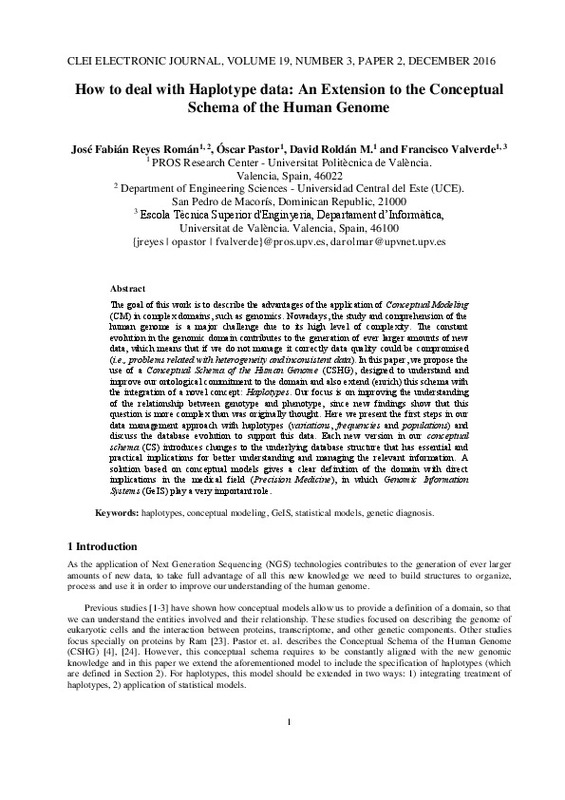JavaScript is disabled for your browser. Some features of this site may not work without it.
Buscar en RiuNet
Listar
Mi cuenta
Estadísticas
Ayuda RiuNet
Admin. UPV
How to deal with Haplotype data: An Extension to the Conceptual Schema of the Human Genome
Mostrar el registro sencillo del ítem
Ficheros en el ítem
| dc.contributor.author | REYES ROMÁN, JOSÉ FABIÁN
|
es_ES |
| dc.contributor.author | Pastor López, Oscar
|
es_ES |
| dc.contributor.author | Roldán Martínez, David
|
es_ES |
| dc.contributor.author | Valverde Giromé, Francisco
|
es_ES |
| dc.date.accessioned | 2017-06-13T07:33:16Z | |
| dc.date.available | 2017-06-13T07:33:16Z | |
| dc.date.issued | 2016-12 | |
| dc.identifier.issn | 0717-5000 | |
| dc.identifier.uri | http://hdl.handle.net/10251/82704 | |
| dc.description.abstract | [EN] The goal of this work is to describe the advantages of the application of Conceptual Modeling (CM) in complex domains, such as genomics. Nowadays, the study and comprehension of the human genome is a major challenge due to its high level of complexity. The constant evolution in the genomic domain contributes to the generation of ever larger amounts of new data, which means that if we do not manage it correctly data quality could be compromised (i.e., problems related with heterogeneity and inconsistent data). In this paper, we propose the use of a Conceptual Schema of the Human Genome (CSHG), designed to understand and improve our ontological commitment to the domain and also extend (enrich) this schema with the integration of a novel concept: Haplotypes. Our focus is on improving the understanding of the relationship between genotype and phenotype, since new findings show that this question is more complex than was originally thought. Here we present the first steps in our data management approach with haplotypes (variations, frequencies and populations) and discuss the database evolution to support this data. Each new version in our conceptual schema (CS) introduces changes to the underlying database structure that has essential and practical implications for better understanding and managing the relevant information. A solution based on conceptual models gives a clear definition of the domain with direct implications in the medical field (Precision Medicine), in which Genomic Information Systems (GeIS) play a very important role. | es_ES |
| dc.description.abstract | [ES] El objetivo de este trabajo es describir las ventajas de la aplicación del Modelado Conceptual (MC) en dominios complejos, como la genómica. Hoy en día, el estudio y comprensión del genoma humano es un desafío importante debido a su alto nivel de complejidad. La constante evolución en el dominio genómico contribuye a la generación de grandes cantidades de datos nuevos, lo que significa que, si no lo gestionamos correctamente, la calidad de los mismos podría verse comprometida (por ejemplo: problemas relacionados con la heterogeneidad e inconsistencia de datos). En este trabajo se propone el uso de un Esquema Conceptual del Genoma Humano (ECGH), diseñado para comprender y mejorar nuestro compromiso ontológico con el dominio y extender este esquema con la integración de un nuevo concepto: Haplotipos. Nuestro objetivo es mejorar la comprensión de la relación entre genotipo-y-fenotipo, ya que los nuevos hallazgos muestran que este tema es mucho más complejo de lo que se pensaba originalmente. Aquí presentamos los primeros pasos en nuestro enfoque de gestión de datos haplotípicos (variaciones, frecuencias y poblaciones) y discutimos la evolución de la base de datos para apoyar dichos datos. Cada nueva versión de nuestro esquema conceptual (EC) introduce cambios en la estructura de la base de datos subyacente, que tiene implicaciones esenciales y prácticas con el fin de facilitar una mejor comprensión y gestión de la información relevante. Una solución basada en modelos conceptuales brinda una definición más clara del dominio con implicaciones directas en el campo médico (Medicina de precisión), en la que los Sistemas de Información Genómicos (GeIS) desempeñan un papel muy importante. | es_ES |
| dc.description.sponsorship | The authors thanks to the members of the PROS Center Genome group for fruitful discussions. This work has been supported by the Ministry of Higher Education, Science and Technology (MESCyT) of the Dominican Republic, and It also has the support of Generalitat Valenciana through project IDEO (PROMETEOII/2014/039) | |
| dc.language | Inglés | es_ES |
| dc.publisher | Centro Latinoamericano de Estudios en Informática | es_ES |
| dc.relation.ispartof | CLEI Electronic Journal | es_ES |
| dc.rights | Reconocimiento (by) | es_ES |
| dc.subject | Haplotypes | es_ES |
| dc.subject | Conceptual modeling | es_ES |
| dc.subject | GeIS | es_ES |
| dc.subject | Statistical models | es_ES |
| dc.subject | Genetic diagnosis | es_ES |
| dc.title | How to deal with Haplotype data: An Extension to the Conceptual Schema of the Human Genome | es_ES |
| dc.type | Artículo | es_ES |
| dc.identifier.doi | 10.19153/cleiej.19.3.2 | |
| dc.relation.projectID | info:eu-repo/grantAgreement/GVA//PROMETEOII%2F2014%2F039/ES/IDEO: Innovative services for Digital Enterprises with ORCA (Servicios Innovadores para Empresas Digitales con ORCA)/ | es_ES |
| dc.rights.accessRights | Abierto | es_ES |
| dc.contributor.affiliation | Universitat Politècnica de València. Escola Tècnica Superior d'Enginyeria Informàtica | es_ES |
| dc.description.bibliographicCitation | Reyes Román, JF.; Pastor López, O.; Roldán Martínez, D.; Valverde Giromé, F. (2016). How to deal with Haplotype data: An Extension to the Conceptual Schema of the Human Genome. CLEI Electronic Journal. 19(3):1-21. https://doi.org/10.19153/cleiej.19.3.2 | es_ES |
| dc.description.accrualMethod | S | es_ES |
| dc.relation.publisherversion | http://dx.doi.org/10.19153/cleiej.19.3.2 | es_ES |
| dc.description.upvformatpinicio | 1 | es_ES |
| dc.description.upvformatpfin | 21 | es_ES |
| dc.type.version | info:eu-repo/semantics/publishedVersion | es_ES |
| dc.description.volume | 19 | es_ES |
| dc.description.issue | 3 | es_ES |
| dc.relation.senia | 320922 | es_ES |
| dc.contributor.funder | Generalitat Valenciana | |
| dc.contributor.funder | Ministerio de Educación Superior, Ciencia y Tecnología, República Dominicana | es_ES |








